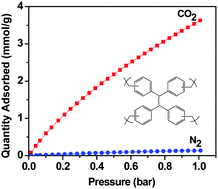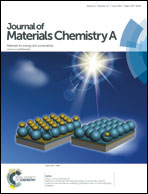High surface area hypercrosslinked microporous organic polymer networks based on tetraphenylethylene for CO2 capture†
Abstract
A series of hypercrosslinked microporous organic polymer and copolymer networks has been synthesized via Friedel–Crafts alkylation of tetraphenylethylene (TPE) and/or 1,1,2,2-tetraphenylethane-1,2-diol (TPD) using a formaldehyde dimethyl acetal crosslinker promoted by anhydrous FeCl3. Statistical copolymerization demonstrates that the ratios of the micropore surface area and the micropore volume for the resulting polymer networks could be controlled by adjusting the content of TPD segments. The polymer network with 100% TPE shows high Brunauer–Emmet–Teller specific surface area up to 1980 m2 g−1 with a CO2 uptake ability of 3.63 mmol g−1 (1.0 bar and 273 K), while the polymer network with 100% TPD shows the highest CO2/N2 selectivity of 119 : 1, although it exhibits the lowest CO2 uptake ability of 1.92 mmol g−1 (1.0 bar and 273 K) among the resulting polymer networks. The increased TPD content in the hypercrosslinked polymer networks led to improved CO2/N2 selectivity, suggesting an efficient strategy for the design of microporous organic polymers for post-combustion carbon capture. Due to the high surface area, the outstanding CO2 sorption performances, and the inexpensive reagents and catalyst employed, these polymer networks are promising candidates for potential applications in post-combustion CO2 capture and sequestration technology.


 Please wait while we load your content...
Please wait while we load your content...